

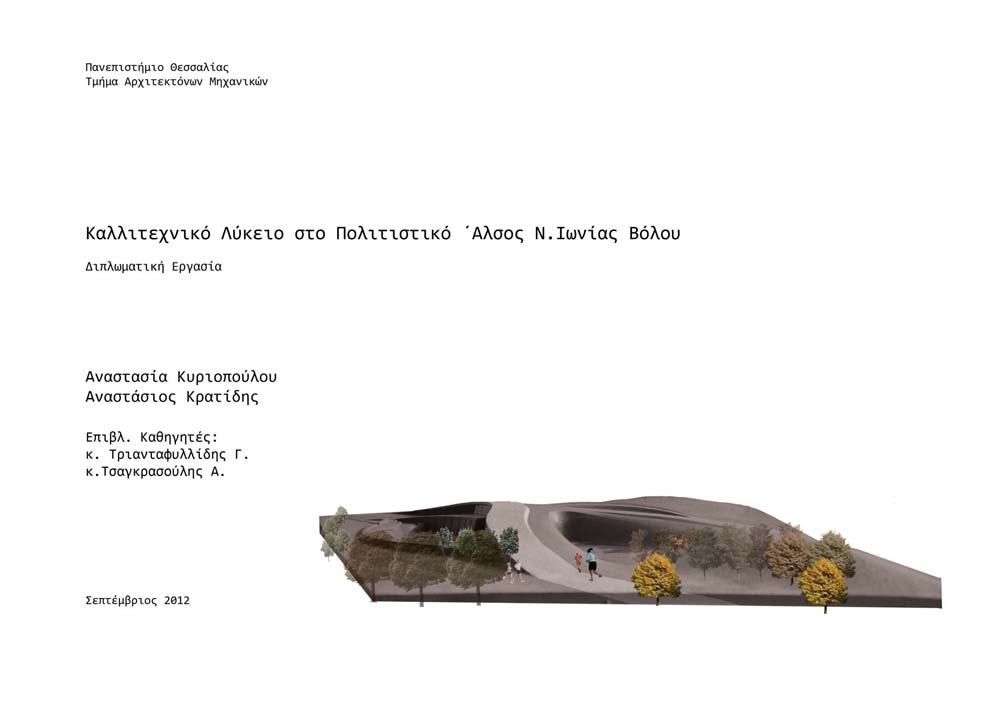



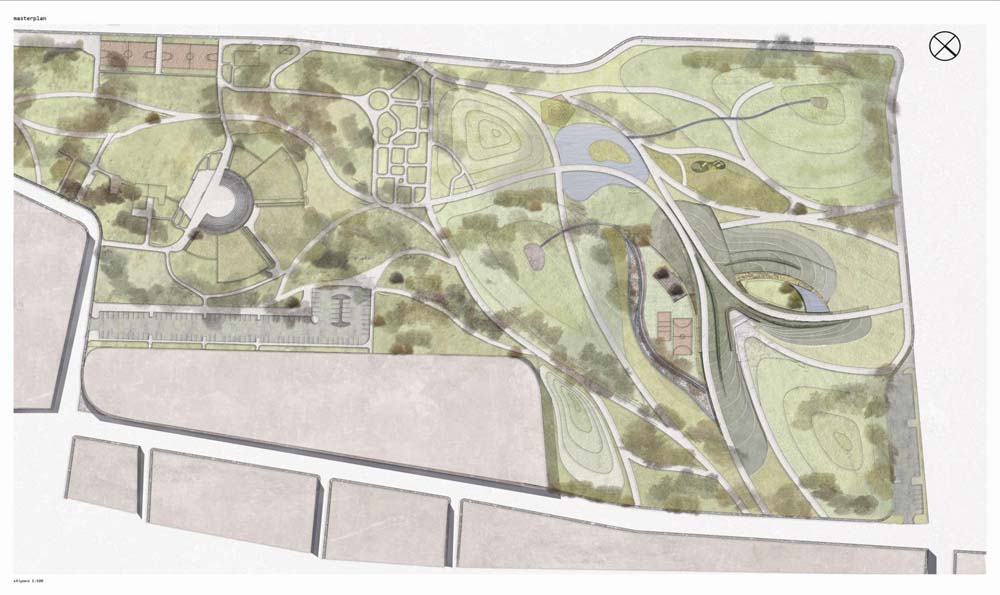

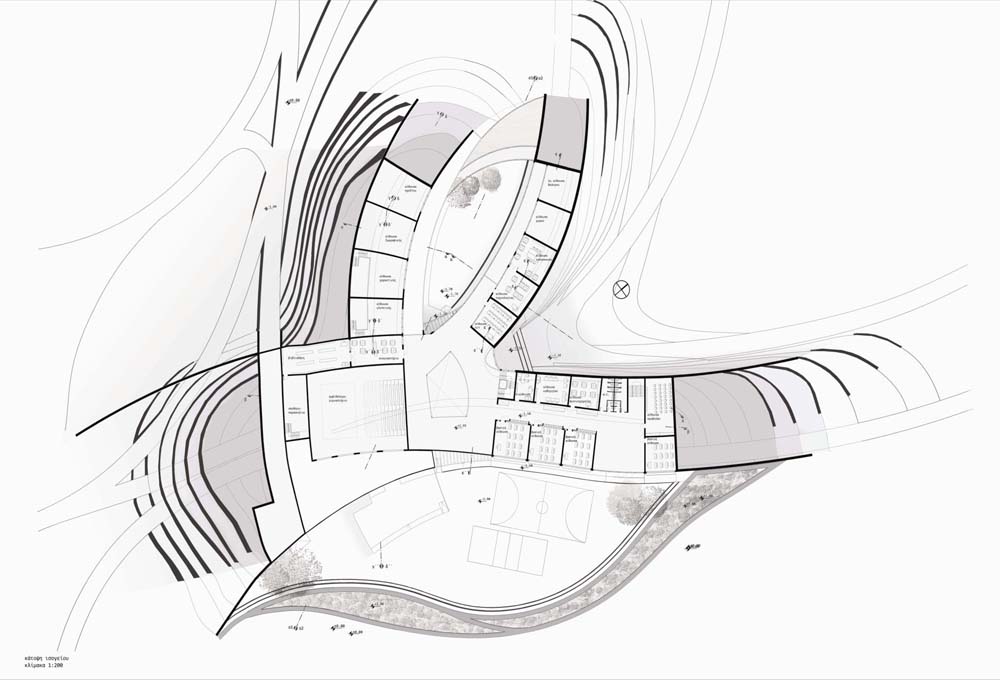

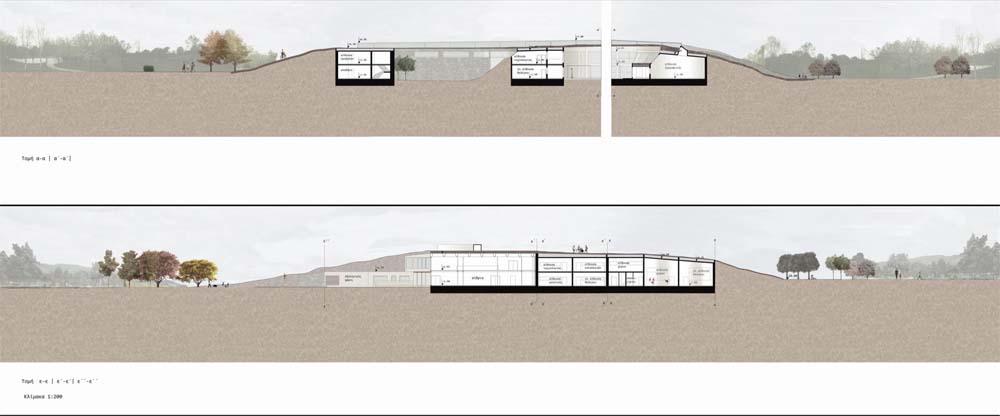

The main subject of this thesis is to design an art school at the Cultural Grove of N. Ionia, Volos, Greece.
Until the 1970's the grove was used as heliport. Gradually hills ,ponds, small footpaths and routes were added ,as well as the Open Public Theatre and Cultural Center of N.Ionia were constructed.Its current form is not the final one, as the respective technical service continues to form it through the years.Although there are serious signs of decline, the park is a green lung of oxygen for the area and is frequently visited by residents of N.Ionia.
In Greece the Art High Schools exist as institution since 2004. There are already three Art High Schools in Gerakas, in Ambeloki (Thessaloniki) and Heraklion. Until the afternoon the normal courses of general high schools are taught. After lunch (there is a school restaurant) students continue until 16:00 with artistic courses. There are common classes for all students and field courses. The fields the students are encouraged to choose among dancing, theater-cinema and visual arts. Their introduction is via admission exams.
The choice of designing a high school, and not a full school campus, was made both for limiting the exploitation of the natural landscape of the grove, and preparing students to admission to higher artistic institutions in a more rural environment.
The process of erosion-corrosion-sedimentation was the basic design concept, since the transportation and replacement of natural materials by the water and / or wind can be found in correspondence with the process of continuous movement, learning and expression of students and young artists. The landscape of the grove creates external stimuli to young artists contributing to their artistic fulfillment.
The building is located in the northwestern part of the grove and is divided into three basic volumes, which through oblique, planted, passable roofs result in small hills, harmonizing with the landscape. These three parts serve both basic and artistic education and are joined into an atrium, where common and cultural events take place . Apart from the basic and artistic classrooms, there is an auditorium-gym, a restaurant, a library and a video library. The presence of two courtyards, one of which is intended primarily for art classes and events, was also important .
From the very beginning, we focused on the building orientation, the use of natural light, wherever necessary, the sufficient shading and use of bioclimatic design strategies to ensure comfortable and healthy working and learning conditions in the school.
Much attention was paid so that the design would not disturb the landscape and character of the grove. The aim was to highlight the grove and transformate it into a semi-urban attraction, with the prospect of further common and cultural uses.
Finally, attention to avoid exclusion of residents from the use of the grove and the routes was severely paid. The paths were redefined according to the typology of the original concept, planting was reinforced , especially around the school, and smaller ponds were added to achieve physical fencing around the school area.
Supervisors: Triantafillidis Giorgos, Tsangrassoulis Aris
Reference Number: 401


In the thesis I have dealt with the association of winter swimmers 'Nereus' in Plakes” outside the city of Volos.
The route:
It is part of the rites of purification of bathers. What changes occur around him visually and in his other senses as well, as he fends off the city?
Bathers:
Who are they, why do they do sea baths in the winter- what do they want to add to the site?
The beach:
The rock-sculpture as a slot for the human body and how heat interacts with it.
The remaining construction of the beach. Observation through proposal.
1:1 construction
The wood as a sculpture - as a recyclable material - as an object in use. Integration with the environment and local materials forming soil. The life of the building - a new sub.
Supervisors: Kotionis Zissis, Papadimitriou Maria
Reference Number: 390


In recent years the relationship of culture to economic and social development of the urban forest has changed. It has become commonly accepted positive effect of the growing population, the city's image, improving the quality of life and its contribution to employment. Additionally associated with the development and promotion of the tourism product through a broader sense of culture. The concept of culture in contemporary life includes not only the arts but also lifestyle, intake of history, the consciousness of society as well as technology evolves.
The building is designed to organic link the city with the sea and the development of cultural features and entertainment in a building that will be a focal point and attraction for locals and foreign visitors. While enhancing the city's identity is directly related to the liquid element.
Specifically, the overriding principle is the inclusion of a new proposal in a general arrangement for buildings, public and commercial use through the overshoot phase of the landscape and the play of two sculptures that make up the tumor in this building at public activities. Simultaneously, the proposal is to create public space (square), which can be a generator of urban renewal, while the new building will be a new architectural symbol, apart from the main uses of the theater will be a catalyst in the development of collective multifaceted activities and organization of services for both local residents and for visitors. In conclusion, the new procedure is designed to function as a social and capacitor as a focus of various cultural events. At the same time, aims to foster and promote knowledge of art, music and theater studies, ie combining the practical and scientific methodology .
Supervisor: Triantafillidis Giorgos
Reference Number: 399


In the last three decades in Greece and especially in the large urban centers of Athens and Thessaloniki presents the problem of homelessness. The issue arises on a new base after 2009 with the onset of economic crisis. Since then a new class of homeless people arise, known as newly homeless. These populations showed adequate standard of living and were led to homelessness as a result of unemployment and / or low incomes.
This final project is about the creation of a center for temporary accommodation and cover of the basic needs of homeless people in Athens. Specifically, the building is located in Piraeos Avenue in the limits of the municipality of Athens and municipality of Taurus, in proximity to residential areas and in an urban axis which condenses cultural and commercial activities and is the main axis connecting the center of Athens with the port of Piraeus.
The goal of this project is to create a building program that attracts different social groups and not only homeless, in order to avoid "ghettoization" and to encourage the reintegration of residents in professional and social life. For this reason, along with the uses that involve only the tenants (guesthouses, cultivation of crops) and the homeless who do not reside in the center (restrooms, restaurant), the building includes also features that attract a wider audience (clinics, government agencies, laboratories).
The composition is based on creating walls that act as load-bearing bodies, on which hung the volumes that house the operating program. Central parts of the composition are the two raised plazas that operate on three levels:
A. At the first level (ground level) are used as a public "open", shaded plaza
B. At the second level (second and fourth floor) are the sanitary and feeding spaces, respectively, seeking to act as social condensers
C. At the third level (third and fifth floor), accessible only by the occupants, is the cultivation of crops
Supervisor: Trova Vasso
Reference Number: 381
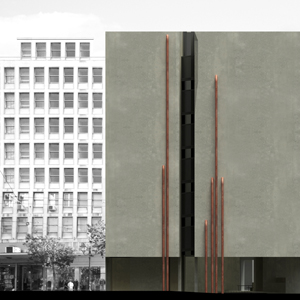

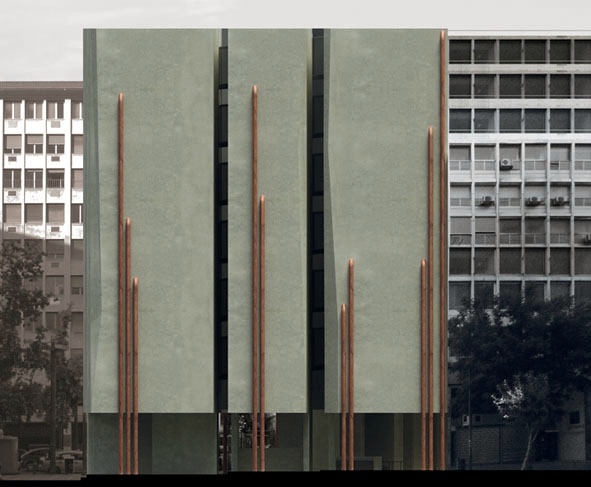

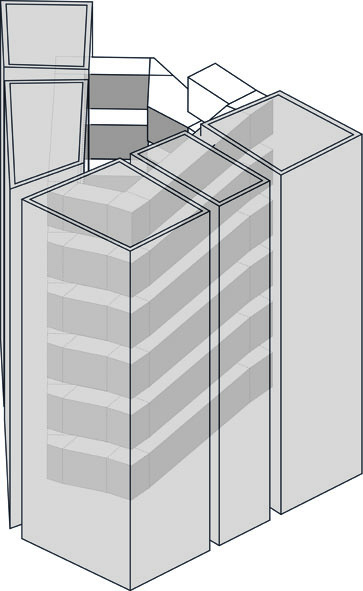

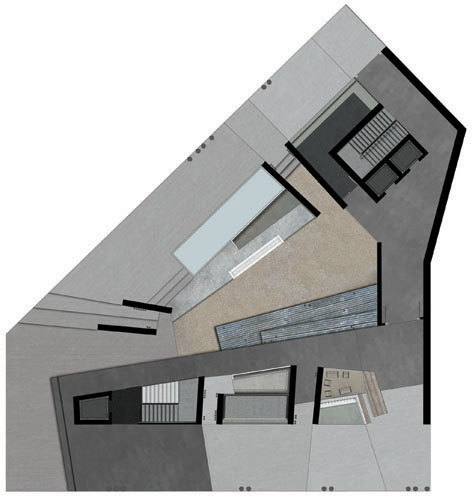

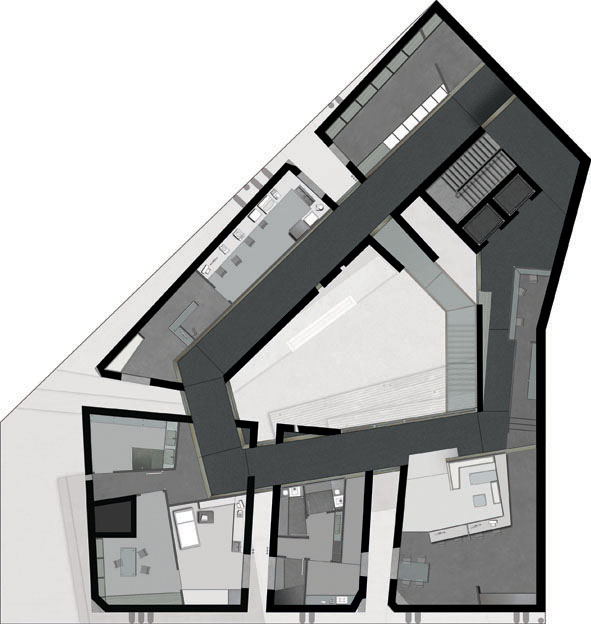

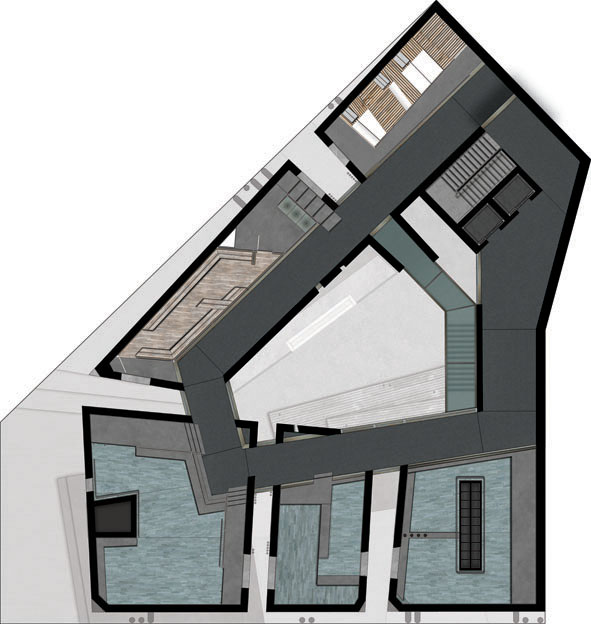

The society that increasingly shapes her environment invented her special technique to process the specific basis of all work: her ground. The public space, as being a field of social projection is also the space where behaviors and relationships are bonding, through the process of collectivization of needs and experiences. The formation of such behaviors is imposed to the users of the space through the planning. The effort of city planning of the European cities and generally the cities of the developed word goes towards to the formation of clean and functional cities. Nowadays, cleanliness and hygiene tend to be achieved through human behavior “cleanups”. Therefore, it is the lack of planning that determines which behaviors are the prohibited ones.
The “Center of collective body practice” is a project, that focuses at these deficiencies and prohibitions, trying to satisfy the physical needs in the public space putting them at the same time in a different context. The main point are the public baths and public toilets. Around the proceedings of the bathroom and toilet a program that includes food, bathroom, medical labs is getting developed.
Considering the importance of the public baths and toilets in a city center, we chose to locate our building in the junction of Stadiou and Aeolou street in the center of Athens. We face the building matching it with the digestive system, where a basic movement axis, crosses different rooms, that match to different functions. The building tries to satisfy the need of public bath and toilets and the need of socialization, public communication and convert the house body practices into collective ones.
Supervisor: Papadopoulos Spiros
Reference Number: 387


The currentpicture of the "KRITON EFSTATHIOU DILAVERIS’ S POTTERY" does not resemble anything in the period of its prosperity. The last 13 years, there have been a series of events that led building to the depreciation and destruction. The "pottery II" is a "dark spot" for the city and need for its rescue and protection is imperative.
The factthat we live near the old factory, and we experience daily the state of abandonment and destruction of this industrial shell, and the interruption of city life in this center-point, prompted us to decide to choose this land and suggest a possible solution for the development of this complex of ceramics through the rehabilitation and integration of new uses for it.
Our primary goalis to reverse the unfavorable conditions and to stop the destructive path of the buildings and the entire estate Dilaveris.
Furthermore, analyzing the data and the needs of the region, we propose the integration of new uses on the existing shells, so that the building no longer constitutes "urban void" and to participate again actively in the daily life of the city.
Our proposalincludes among other things, the conversion of old factory into an Industrial Museum, establishing a public vocational training institutes which will operate as sculpture, photography, handmade jewelry making and decoration, a multipurpose room, two classrooms of 98 and 120 people, four shops and a second chance school.
Supervisor: Adamakis Kostas
Reference Number: 375
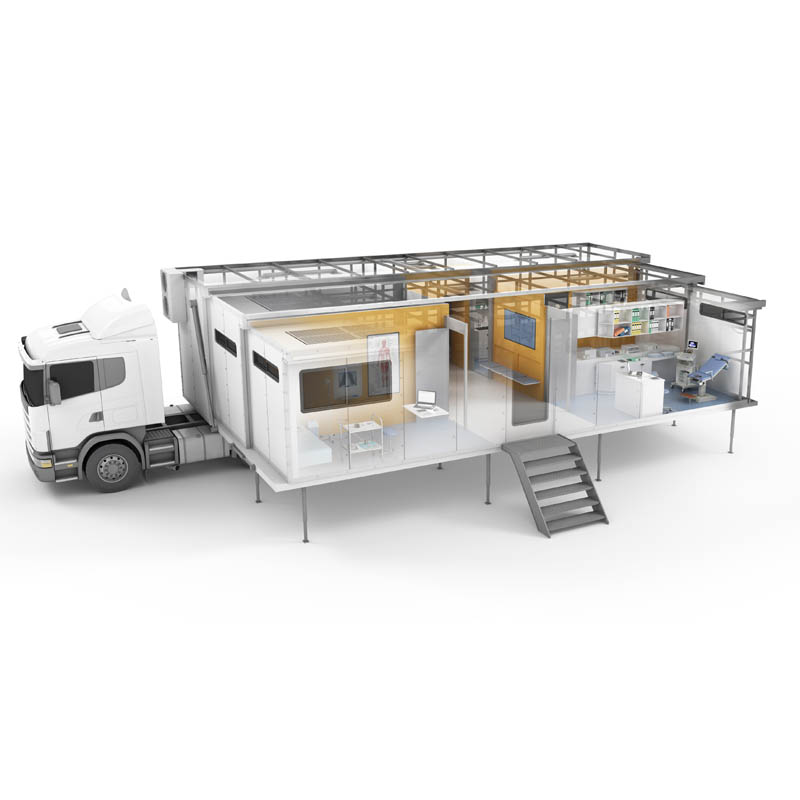



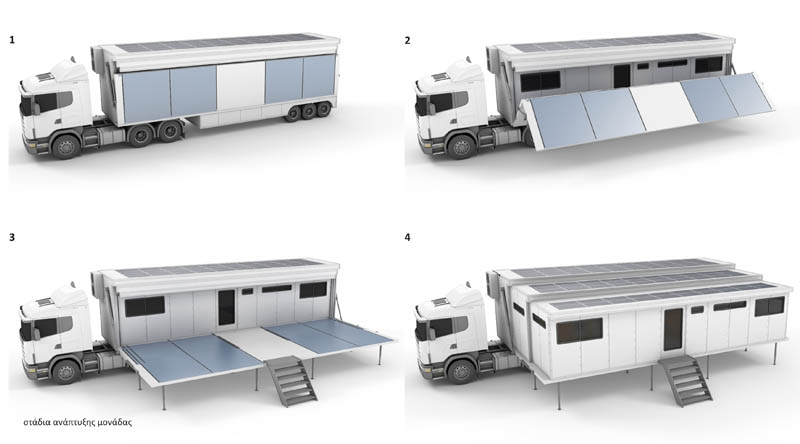

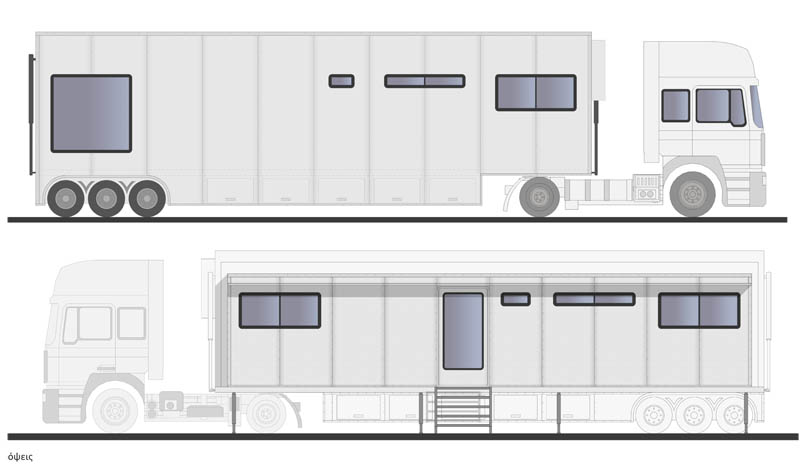

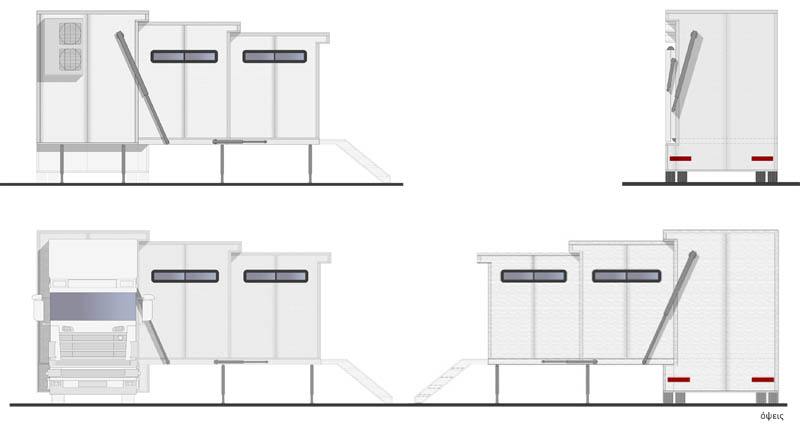



Medical care is one of the most important needs among people of contemporary society. Hos- pitals are usually concentrated within urban centers with a view to serving a large part of the population. Geography of Greece and probably other countries as well, urbanization and several socioeconomical factors can convert the access to such kind of services, from everyday and convenient to exceptionally difficult. Additionally, the use of mobile medical care units has been well established and is used in emergency cases, during natural disasters or wars, as well as in everyday hospital activities. At the same time, examinations at home take place by doctors at a daily basis.
As a result, the need rises for existence of a unit easily transported and with access to remote areas. Based on the applying scenario, the basic medical needs that are chosen to be served in such a unit are the specialties of the dentist, oculist, microbiologist, gynaecologist, patholo- gist and pediatrician. The construction will have to be able to serve those specialties’ activities within the smallest space possible. Therefore, the use of a trailer truck due to dimensions, available initial volume and ability to travel is deemed appropriate for the housing of a mobile medical unit. The utilization of a prototype automated mechanism almost triples the available surface of the trailer, converting it to a full and complete medical care unit, achieving the clin- ics’ operation.
The complex approach is formulated through the mechanical requirements and available space. As far as the construction part is concerned, the logic and the design principles of a camper are followed, factors which affect external design at a great extent. Internal design, on the other hand, focuses on the creation of a pleasant comfortable environment for the patients and doctors as well. In conclusion, the unit has to be autonomous regarding energy and water consumption for the longest possible duration.
The goal of the approach is the establishment of the unit as a medical symbol, which
will offer services to the less favored population groups. Through this specific approach, the establishment and wider utilization of respective units is sought as a basic method of medical care and service for citizens who do not reside in urban centers.
Supervisor: Triantafillidis Giorgos
Reference Number: 396




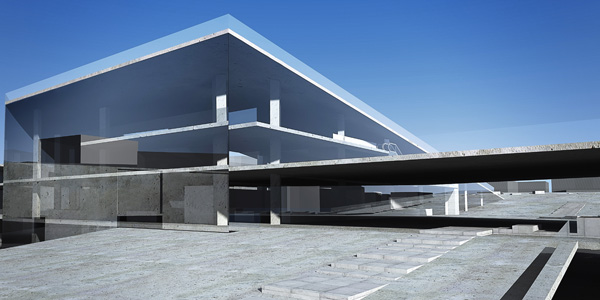

This Diploma Project concerns the creation of a Metropolitan Transport Station in Athens, on the occasion of the upcoming consolidation of the two existing Intercity Bus Stations (Kifissou and Liosion) into a new station on the site of Votanikos. This study attempts to redefine the importance of creating a project of this scale for Athens, proposing its creation within its center. The aim of this new building is to be a landmark for the region of Attica, in matters of transport and traffic, affecting simultaneously the urban fabric and the density of the region in which it is placed. At the same time, it aims to activate the pedestrian system input in its center, especially in areas where it suffers.
The study starts with the finding of the appropriate area for the installation of the program, based on multiple criteria, such as the connectivity of the area with the city networks and its potential to become a new hub for Attica. Then, an attempt is made to create the conditions for placing the program in the region, since, at this stage, it is densely populated. The system that was implemented is called “defragment” and attempts to create spaces within the “innards” of the area, so that the new program can be inserted.
In the design part, three buildings were created in the study area, linked together into five levels (-9.00, -3.00, +0.00, +4.50, +9.00), the main building of the station, the hotel, which is supportive of the station, and the building of Greek Postal Services, which is transferred from the opposite side of Konstantinoupoleos street, where it is today, freeing the space occupied for a potential creation of a park. Simultaneously, insome of the spaces vacated by the removal of the inactive buildings and were not used in the Station, there is the capacity for the creation of garages and other auxiliary functions for the region.
Supervisors: Paniyiris Costis, Gavrilou Evelyn
Reference Number: 420

